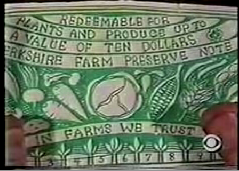Did you know that it is entirely legal to print your own money in the U.S., as long as it does not resemble the U.S. dollar bill?I recently learned about this little know fact. Many communities in the U.S. and many in the world have their own local currency that complements the dollar: Ithaca hours, BayBucks, Deli Dollars are several of the most well-known. The stories behind each of these currencies are fascinating and inspiring, as it reminds us of what each bill money truly is: a unit of a trusted social contract.
During the late 80s, Taft Farms couldn’t raise money from banks to go through the winter. To solve their cash issues, they issued their own money, notes worth 10 US dollars on which you could read “In Farms we Trust” with a cabbage in place of Lincoln. People would buy for $9 in the fall and that would give them the ability to buy $10 worth of produce in the spring. As you can hear from the owner himself in this archived video, the scheme worked because customers fundamentally trusted that these notes would have value in the spring, because they knew they would enable to farm to survive the winter.The Taft Farms note was simply a unit of that trusted social contract and as such had a much higher value than 9 US dollar note. Nine U.S. dollars in autumn gets you ten U.S. dollars worth of produce in the spring.

Depending on how you look at it, that’s a 11.11% interest rate over 6 months (23.45% annualized, which is a very good deal, even if you assume 5% yearly inflation rate of prices in U.S. dollars), or a 10% rebate.Fast forward almost 20 years later with this NetBanker post that describes the value of the social contract in the context of Prosper.com’s peer-to-peer lending community:
Prosper has found that people who receive at least one bid from friends or family have significantly lower default rates than those who only borrow from strangers. By leveraging this social capital, the entire community acts more honestly, even if lending to friends and family is a small part of the overall equation.
In other words, money lent in this way, has more value, then say a zero downpayment, brokered, securitized, and sliced package of hundreds of thousands of loans made to poor credit, zero downpayment buyers of houses in the booming housing market of the 2000s. No one who hasn’t been living under the rock for the last year should be surprised of that. Now, some of you may be surprised to learn that the money bank lend us is very different than the money that you may lend on Prosper.com: most of the money lent by banks does not exist, and they create it from thin air. As John Kenneth Galbraith puts it:
The process by which banks create money is so simple that the mind is repelled.
I encourage you to read JKK’s fascinating book on the history of money Money: Whence it came, where it went, but to keep things simple, bank lend more than they actually have in deposits at the central bank, while charging an interest on all the money they lend. This is known as fractional reserve banking and this is how most of the money is created and why the interest rate set by the Fed is so important. In comparison, Prosper.com and other peer-to-peer lending communities can be seen as a 100% reserve banking system. Like Taft Farms, bank take promises to pay (i.e. provide value) in the future, and exchange it for promises to pay now and charge an interest for it. While Taft Farms did it in the form a currency that can be redeemed for vegetables, banks do it in the form of currency that is legal tender nationwide. Why would the bank not lend Taft Farms money at this rate? because that money is not a reflection of the trusted social contract between the farm and its customers, but simply between the farm and the bank.
Banks are useful simply because they have a given right to issue contracts that become legal tender. Which leads to my guess: in difficult times and declining trust, community money, and community currencies have very likely a much higher value than national currencies like the the dollar, because they are based on a very tangible social contract that minimizes moral hazard.
The local currencies are very popular and seem to be gaining momentum. We have just published a special issue on Complementary Currency and feature what CC’s are working in the US and Canada today.
DGCmagazine
Mark
Community currencies are a 25 year old global movement that is beginning to mature as we learn and apply the lessons from thousands of experiments on every continent. Many systems have not sustained themselves over time, a few have. As we begin to apply the principles of better design, planning and organisation we will begin to see these systems move into the mainstream to provide some of the answers to financial instability, community breakdown and unsustainable practices.
Further resources: ‘Future of Money’ by Bernard Lietaer, http://www.reinventingmoney.com by Thomas Greco, Value for People services from John Rogers http://www.valueforpeople.co.uk
The local currencies are very popular and seem to be gaining momentum. We have just published a special issue on Complementary Currency and feature what CC's are working in the US and Canada today.
DGCmagazine
Mark